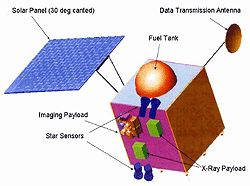
Chandrayaan 1 Lunar Orbiter
NSSDC ID: 2008-052A
Description
Chandrayaan-1 is an Indian Space Research Organization (ISRO) mission designed to orbit the Moon over a two year period with the objectives of upgrading and testing India's technological capabilities in space and returning scientific information on the lunar surface. The spacecraft bus is roughly a 1.5 meter cube with a dry weight of 523 kg (Launch mass of the system, including its Lunar Apogee Motor, LAM, is 1380 kg). It is based on the Kalpansat meteorological satellite. Power is provided by a solar array which generates 750 W and charges lithium ion batteries. A bipropellant propulsion system is used to transfer Chandrayaan-1 into lunar orbit and maintain attitude. The spacecraft is 3-axis stabilized using attitude control thrusters and reaction wheels. Knowledge is provided by star sensors, accelerometers, and an inertial reference unit. Telecommand communications will be in S-band and science data transmission in X-band.
The scientific payload has a mass of 55 kg and contains three Indian instruments. The Terrain Mapping Camera (TMC) has 5 meter resolution and a 40 km swath in the panchromatic band and will be used to produce a high-resolution map of the Moon. The Hyper Spectral Imager (HySI) will perform mineralogical mapping in the 400-900 nm band with a spectral resolution of 15 nm and a spatial resolution of 80 m. The Lunar Laser Ranging Instrument (LLRI) will determine the surface topography. A fourth instrument, an X-ray flourescence spectrometer, will have three components: an Imaging X-ray Spectrometer (CIXS) covering 1 - 10 keV with a ground resolution of 10 km, a High Energy X-ray/gamma ray spectromenter (HEX) for 10 - 200 keV measurements with ground resolution of about 20 km, and a Solar X-ray Monitor (SXM) to detect solar flux in the 2 - 10 keV range. CIXS will be used to map the abundance of Si, Al, Mg, Ca, Fe, and Ti at the surface, the HEX will measure U, Th, 210Pb, 222Rn degassing, and other radioactive elements, and the SXM will monitor the solar flux to normalize the results of CIXS and HEX. The Sub-keV Atom Reflecting Analyzer (SARA) will map composition using low energy neutral atoms sputtered from the surface. The Moon Mineralogy Mapper (M3) is an imaging spectrometer designed to map the surface mineral composition. A near-infrared spectrometer (SIR-2) will also map the mineral composition using an infrared grating spectrometer. The Miniature Synthetic Aperture Radar (Mini-SAR) will perform radar scattering and imaging investigations at the poles in a search for water ice. A Bulgarian instrument, the Radiation Dose Monitor (RADOM-7), will also fly on the mission to characterize the local radiation environment.
Chandrayaan-1 will also carry a 35 kg Moon Impact Probe (MIP) designed to be released from the spacecraft and hit the lunar surface. The MIP carried a video camera, a radar altimeter, and a mass spectrometer. The side panels of the box-like probe were painted with the Indian flag.
The spacecraft launched on a PSLV C11 (Polar Satellite Launch Vehicle) from the Satish Dhawan Space Center in Sriharikota on the southeast coast of India on 22 October 2008 at 00:52 UT (6:22 a.m. local time). The PSLV injected Chandrayaan-1 into a 255 x 22860 km transfer orbit with an inclination of 17.9 degrees. Reaching lunar transfer trajectory involved five firings of the LAM increasing the eccentricity of the orbit around the Earth to a final apogee of 380,000 km on 4 November. On 8 November Chandrayaan was put into a 7502 x 504 km lunar polar orbit, and then lowered into a 100 km circular polar orbit. On 14 November at 14:36:54 UT the Moon Impact Probe was released and hit the lunar surface at 15:01 UT near the Moon's south pole. All three instruments returned data before the crash. The orbiter will return data for at least two years. Chandrayaan means "Moon Craft" in ancient Sanskrit. Total cost of the mission is estimated at INR 3.8 billion ($83 million U.S.).
Alternate Names
- Chandrayaan 1
- 33405
Facts in Brief
Launch Date: 2008-10-22
Launch Vehicle: Polar Satellite Launch Vehicle C11
Launch Site: Sriharikota, India
Mass: 523.0 kg
Nominal Power: 750.0 W
Funding Agency
- Indian Space Research Organization (India)
Discipline
- Planetary Science
Additional Information
- Launch/Orbital information for Chandrayaan 1 Lunar Orbiter
- PDMP information for Chandrayaan 1 Lunar Orbiter
- Telecommunications information for Chandrayaan 1 Lunar Orbiter
Experiments on Chandrayaan 1 Lunar Orbiter
Data collections from Chandrayaan 1 Lunar Orbiter
Questions or comments about this spacecraft can be directed to: Dr. David R. Williams.
Personnel
| Name | Role | Original Affiliation | |
|---|---|---|---|
| Dr. Jayati Datta | Mission Manager | Indian Space Research Organization | jayati@isro.org |
Selected References
Bhandari, N., Chandrayaan-1: Science goals, J. Earth Syst. Sci., 114, No. 6, 701-709, Dec. 2005.
PSLV-C11 Successfully Launches Chandrayaan-1 (ISRO Press Release, 22 October 2008)NASA Selects Moon Mapper to Compete to Fly on Chandrayaan-1 (NASA Press Release, 2 February 2005)
Chandrayaan-1 Home Page
Chandrayaan-1 Announcement of Opportunity
Indian Space Research Organization (ISRO) Home Page

